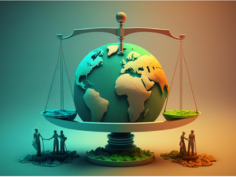What you’ll acquire:
- Acquire an in-depth understanding of core modules pertaining to legal frameworks and standards.
- Grasp the foundational and advanced principles of the Environmental law.
- Enhance analytical skills to dissect complex legal issues and formulate cohesive arguments through the application of legal theories and doctrines.
- Prepare comprehensively for the bar exam or other legal examinations through a well-structured curriculum and focused study materials.
Ready for law? Here's what you need!
- Fundamental knowledge of jurisprudence concepts
- A proactive attitude toward understanding legal frameworks
- Competency in critical analysis and reasoning
- Proficiency in verbal and written communication
- A keen interest in societal structures and norms
- Commitment to ethical practices and integrity in the field of law
Description:
Greetings! Everyone, I am honoured to be your guide on this enlightening journey through the complexities of the law. This course has been meticulously designed to provide an in-depth understanding and mastery of various branches of law, offering valuable insights and materials to accelerate your learning curve.
Who can benefit from this course?
Whether you're an aspiring legal professional embarking on your LLB journey, gearing up for your exams, or an enthusiast keen to unravel the world of law, the Environmental law caters to a wide spectrum of learners. We cover a well-rounded curriculum that encapsulates both traditional and contemporary branches of law, designed to give you a holistic perspective.
Comprehensive curriculum featuring: Environmental law
Concept of environment and pollution: The concept of environment and pollution refers to the understanding of the natural surroundings and the adverse effects caused by human activities on these surroundings. It encompasses the study of how human actions can degrade the air, water, and land, leading to pollution and environmental harm. Understanding this concept is crucial for devising sustainable practices that preserve and protect our environment.
Constitutional perspectives: Constitutional perspectives pertain to the interpretation and analysis of a country's constitution, examining its fundamental principles, structures, rights, and the distribution of powers among various branches of government. These perspectives provide insights into the legal framework and foundational principles that guide governance and uphold citizens' rights within a nation.
Water and air pollution: Water and air pollution involve the contamination of natural resources essential for life. Water pollution refers to the degradation of water quality due to the introduction of harmful substances, making it unfit for various uses. Similarly, air pollution pertains to the presence of pollutants in the air, often resulting from industrial emissions, vehicle exhaust, and other human activities, adversely affecting human health and the environment.
Noise pollution: Noise pollution refers to excessive or disruptive sounds that disturb the natural acoustic environment. These unwanted noises can be caused by industrial activities, transportation, urban development, and various human endeavours. Noise pollution can have detrimental effects on human health, leading to stress, hearing impairments, and other related issues.
Protection agencies: Power and functions: Protection agencies are entities established by governments to monitor, regulate, and enforce laws and regulations related to environmental protection. Their power and functions include setting and enforcing environmental standards, conducting inspections, issuing permits, promoting sustainable practices, and penalizing violators. These agencies play a crucial role in safeguarding the environment and ensuring compliance with environmental laws.
Environment protection: Environment protection encompasses actions and measures aimed at preserving, conserving, and restoring the natural environment. It involves efforts to mitigate pollution, protect biodiversity, promote sustainable resource usage, and create awareness about environmental issues. The goal is to maintain a healthy and sustainable environment for present and future generations.
Forest and greenery: Forest and greenery refer to the lush vegetation and tree-covered areas that contribute to the natural ecosystem. Forests play a vital role in maintaining ecological balance, supporting wildlife habitats, absorbing carbon dioxide, and providing various ecosystem services. Greenery, in general, symbolizes the importance of vegetation in enhancing the beauty of landscapes and promoting a healthy environment.
Biodiversity: Biodiversity, short for biological diversity, encompasses the variety and variability of life on Earth, including different species of plants, animals, microorganisms, and ecosystems. It includes genetic diversity, species diversity, and ecosystem diversity. Biodiversity is crucial for ecological stability, ecosystem services, food security, medicine, and overall environmental health.
International regime: International regime refers to a set of rules, agreements, and institutions established at the international level to address specific global issues. In the context of environmental conservation, it pertains to international agreements and frameworks aimed at addressing environmental challenges on a global scale. These regimes facilitate cooperation among nations to tackle issues such as climate change, biodiversity loss, pollution, and sustainable development.
Exclusive Resources and Materials:
Interactive Video Lectures: Engage in dynamic video lectures that facilitate a deeper understanding of the Environmental law.
Subject-Specific Assignments: Hone your analytical and critical thinking skills with assignments tailored to the Environmental law.
Multiple Choice Questions (MCQs): Test your knowledge through a series of MCQs designed to reinforce your understanding of the Environmental law.
Short Q&A Sessions: Participate in brief Q&A sessions to clarify doubts and foster the Environmental law.
Comprehensive Study Material: Gain access to an extensive collection of study materials that support your learning journey at every step of the Environmental law.
Your Gateway to Legal Mastery:
The Environmental Law aims to be your one-stop destination for legal expertise, offering a robust set of tools and resources that I used to excel in my LL.B. program. It serves as an excellent precursor for those venturing into their degrees and a refresher for those gearing up for their exams.
Join us in this legal endeavor:
Thank you for considering the Environmental law as a step towards achieving your educational aspirations in the field of law. We eagerly await the opportunity to facilitate your journey to becoming a legal aficionado.
See you on the course!






